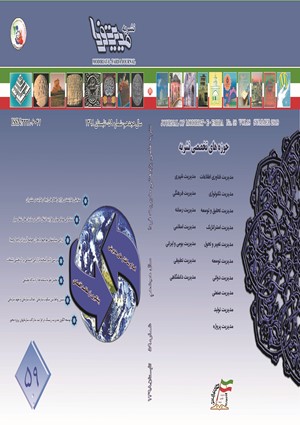Analyzing influential factors on non-oil export development in terms of risk in Iran’s Custom Administration
Subject Areas :Maryam Tanabandeh 1 , Sanjar Salajegheh 2
1 -
2 - دانشگاه آزاد اسلامی واحد کرمان
Keywords: Risk management Customs procedures Non-Oil export Gounded theory ,
Abstract :
Trade affairs, particularly export, have been always encountered with risks and uncertainties. It is obvious that coping with these risk categories requires a systematic process for identifying, analyzing and responding to the risks in order to maximize the results of positive events and minimizing the consequences of bad and negative events that can affect the main goals of export. Accordingly, the aim of this study is to design and determine the optimal risk management model and its executive requirements in the Islamic Republic of Iran's Custom Administration (IRICA) with the export development approach. The statistical population of the research in the qualitative section was the managers and experts of the IRICA in Tehran and in the quantitative section, was all experts of customs with a definitive export procedure. The sample needed for qualitative interviews was collected to the extent of theoretical saturation through a targeted judgment sampling. The qualitative data was analyzed by the grounded theory. Out of 181 subcategories extracted from verbal propositions, 41 core categories were extracted which formed the paradigm model of export risk management. Results indicated that product-based risk, trade risk, export decleration risk, non-performance risk, credit risk, transportation risk, individual based risk, and legal risk are the main export risks in Iran and related strategies were suggested. In addition, contextual factors including cultural, legal, environmental, economic, and political facors as well as mediator factors including quality of export operation mechanisms, human resource quality and stakeholder participation have affectd the risk management strategies.
توکلي، محمد. (1392)، شناسايي و ارزيابي شاخص هاي مديريت ريسک در صادرات مايعات گازي پارس جنوبي، پايان نامه کارشناسي ارشد، دانشگاه آزاد اسلامي، واحد تهران شمال.
زارعي، جواد. (1378)، تجزيه و تحليل ريسک و مديريت ريسک صادرات کالاهاي صنعتي ايران (کاشي، سراميک و چيني)، فصلنامه صنعت بيمه، شماره 54، صفحات. 101-112.
زارعي، زينب. و چمني، قباد. (1392)، مديريت ريسک و الزامات اجرايي آن در گمرک، دومين همايش ملي علوم مديريت نوين، قابل دسترس در: https://www.civilica.com/Paper-CMMS02-CMMS02_467.html
عباسي، ابراهيم. و رمضانيان، احسان. (1394)، شناسايي و ارزيابي مالي پروژه هاي BOT با رويکرد مديريت ريسک با استفاده از روش AHP-DEA، دانش مالي تحليل اوراق بهادار، دوره 8، شماره 25، صفحات. 69-79.
علي اصغري، سوگند.، احمدي آبكنار، فاطمه. و شاه بهرامي، اسدالله. (1394)، شناسايي ريسک¬هاي سامانه¬اي و کسب و کار و مديريت ريسک در گمرک، کنفرانس ملي مديريت ريسک سازماني، قابل دسترس از طريق: http://www.civilica.com/Paper-ERMCONF01-ERMCONF01_012.html
محمدي، علي.، شجاعي، پيام.، يزداني، حميدرضا. و صادقي، محمدرضا. (1395)، مديريت ريسک زنجيره تأمين پروژه ها در خطوط انتقال گاز: رويکرد تئوري برخاسته از داده ها، مطالعات مديريت صنعتي، دوره 14، شماره 42، صفحات. 169-197.
مهدي خاني، مهدي. (1394)، تحليل، ارزيابي، و مديريت ريسک پروژه هاي عمراني دريايي به روش FMEA منطبق بر PMBOK، هفدهمين همايش صنايع دريايي، 1 الي 4 دي ماه، جزيره کيش.
نعمتي، نرگس. و نعمتي زاده، سينا. (1394)، توسعه سيستم پشتيبان تصميم مديريت ريسک سازمان در شرکت توسعه و نگهداري اماکن ورزشي کشور، آينده پژوهي مديريت، دوره 26، شماره 2، صفحات. 41-57.
نوري، مهدي. و نويدي، حامد. (1391)، ريسک نرخ ارز و صادرات غيرنفتي در ايران، پژوهش هاي رشد و توسعه اقتصادي، سال 3، شماره 9، صفحات. 59-70.
Biljan, J. and Trajkov, A. (2012), Risk management and Customs performance improvements: The case of the Republic of Macedonia, Procedia-Social and Behavioral Sciences, Vol. 44 pp. 301-313.
Bowen, C. C. & Bowen, W. M. (2008), Content Analysis; In Kaifeng Yang and Gerald J. Miller, Handbook of research methods in public administration, Taylor & Francis Publications.
Ellegaard, C. (2008), Supply risk management in a small company perspective, Supply Chain Management: An International Journal, Vol. 13 No. 6 pp. 425-434.
Jairaman, J., Sakiman, Z., and Suan Li, L. (2017), Sunway Medical Laboratory Quality Control Plans Based on Six Sigma, Risk Management and Uncertainty, Clin Lab Med, Vol. 37, pp. 163-176.
Javani, B., Mutajwaa, P. and Rwelamila, D. (2016), Risk management in IT projects-a case of the South African public sector, International Journal of Managing Projects in Business, Vol. 9 No. 2 pp. 389-413.
Liu,J., Hu, Y. and Xiao, Y. (2017), Risk management for rural energy industry of Sichuan Province in China, Renewable and Sustainable Energy Reviews, Vol. 69, pp. 1029-1044.
Manuj, I. and Mentzer, J. T. (2008), Global supply chain risk management strategies, International Journal of Physical Distribution & Logistics Management, Vol. 38 No. 3 pp. 192-223.
Miller, L. (2015), They Do What?: A Cultural Encyclopedia of Extraordinary and Exotic Customs from Around the World, Reference Reviews, Vol. 29 No. 2, pp.23-24.
Park, Y. B. and Kim, H. S. (2016), Simulation-based evolutionary algorithm approach for deriving the operational planning of global supply chains from the systematic risk management, Computers in Industry, Vol. 83, pp. 68–77.
Reim, W., Parida, V. and Sjödin, D. R. (2016), Risk management for product-service system operation, International Journal of Operations & Production Management, Vol. 36 No. 6, pp. 665-686.
Shrivastava, S. V. and Rathod, U. (2017), A risk management framework for distributed agile projects, Information and Software Technology, forthcoming paper, pp. 1-15.
Tummala, R. and Schoenherr, T. (2011), Assessing and managing risks using the Supply Chain Risk Management Process (SCRMP), Supply Chain Management: An International Journal, Vol. 16 No. 6, pp. 474-483.
Valtonena, E., Falkenbach, H. and van der Krabben, E. (2017), Risk management in public land development projects: Comparativecase study in Finland, and the Netherlands, Land Use Policy, Vol. 62, pp. 246-257.
Vilkoa,J., Ritalaa, P. and Hallikas, J. (2016), Risk management abilities in multimodal maritime supply chains:Visibility and control perspectives, Accident Analysis and Prevention, forthcoming paper, pp. 1-13.


